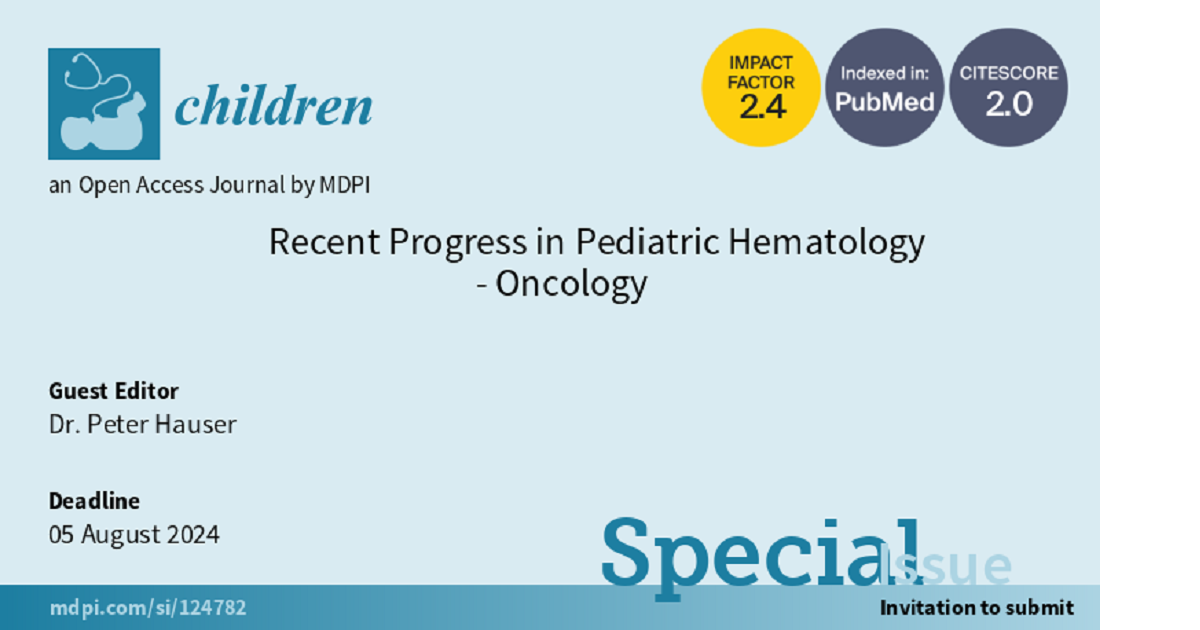Recent Progress in Pediatric Hematology-Oncology
A special issue of Children (ISSN 2227-9067). This special issue belongs to the section "Pediatric Hematology & Oncology".
Deadline for manuscript submissions: closed (5 August 2024) | Viewed by 14664

Special Issue Editor
Interests: pediatric oncology; pediatric brain tumor; pediatrics cancer; pediatric cancer therapy; pediatric hematology
Special Issues, Collections and Topics in MDPI journals
Special Issue Information
Dear Colleagues,
In recent years, significant progress has been observed in the field of pediatric hematology–oncology. The wide use of new molecular techniques (e.g., NGS and methylation profiles) has provided a deeper insight into the diagnostic and prognostic classification of pediatric malignancies. The introduction of liquid biopsy techniques from blood could aid quicker diagnosis, easier follow-up of the response to therapy, and a deeper insight into the non-cellular components of a malignancy. A better understanding of the immuno-microenvironment of tumors, and discoveries of tumor- immunogenicity, have led to new immuno-driven therapeutic methods, which try to confine the use of chemotherapy and may provide a better long-term control of the disease. The systematic long-term follow-up of pediatric patients provides new aspects in the application of different therapies. Deeper insight into the medical communication of pediatric health care professionals could provide a better communication approach for parents and patients.
This Special Issue aims to provide a wide overview of recent advances in the field of pediatric hematology and oncology, not only for pediatric oncologists, but for all specialists in the field of pediatrics.
Dr. Peter Hauser
Guest Editor
Manuscript Submission Information
Manuscripts should be submitted online at www.mdpi.com by registering and logging in to this website. Once you are registered, click here to go to the submission form. Manuscripts can be submitted until the deadline. All submissions that pass pre-check are peer-reviewed. Accepted papers will be published continuously in the journal (as soon as accepted) and will be listed together on the special issue website. Research articles, review articles as well as short communications are invited. For planned papers, a title and short abstract (about 100 words) can be sent to the Editorial Office for announcement on this website.
Submitted manuscripts should not have been published previously, nor be under consideration for publication elsewhere (except conference proceedings papers). All manuscripts are thoroughly refereed through a single-blind peer-review process. A guide for authors and other relevant information for submission of manuscripts is available on the Instructions for Authors page. Children is an international peer-reviewed open access monthly journal published by MDPI.
Please visit the Instructions for Authors page before submitting a manuscript. The Article Processing Charge (APC) for publication in this open access journal is 2400 CHF (Swiss Francs). Submitted papers should be well formatted and use good English. Authors may use MDPI's English editing service prior to publication or during author revisions.
Keywords
- liquid biopsy
- molecular diagnostic methods
- immunotherapy
- long-term follow-up
- communication of health care professionals
- prognosis
Benefits of Publishing in a Special Issue
- Ease of navigation: Grouping papers by topic helps scholars navigate broad scope journals more efficiently.
- Greater discoverability: Special Issues support the reach and impact of scientific research. Articles in Special Issues are more discoverable and cited more frequently.
- Expansion of research network: Special Issues facilitate connections among authors, fostering scientific collaborations.
- External promotion: Articles in Special Issues are often promoted through the journal's social media, increasing their visibility.
- Reprint: MDPI Books provides the opportunity to republish successful Special Issues in book format, both online and in print.
Further information on MDPI's Special Issue policies can be found here.






